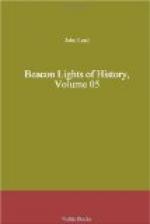Closely connected with papal exactions was the enormous increase of the Mendicant friars, especially the Dominicans and Franciscans, who had been instituted by Innocent III. to uphold the papal domination. These itinerating beggars in their black-and-gray gowns infested every town and village in England. For a century after their institution, they were the ablest and perhaps the best soldiers of the Pope, and did what the Jesuits afterwards performed, and perhaps the Methodists a hundred years ago,—gained the hearts of the people and stimulated religious life; but in the fourteenth century they were a nuisance. They sold indulgences, they invented pious frauds, they were covetous under pretence of poverty, they had become luxurious in their lives, they slandered the regular clergy, they usurped the prerogatives of parish priests, they enriched their convents, they accommodated themselves to the wishes of the great, and were marked by those peculiarities of which the Jesuits were accused in the time of Pascal. As they had not in England, as in Spain and Italy, tribunals of inquisition, they were ridiculed, despised, and hated, rather than feared. One gets the truest impression of the popular estimate of these friars from the sarcasms of Chaucer. The Friar Tuck whom Sir Walter Scott has painted was a very different man from the Dominicans or the Franciscans of the thirteenth century, when they reigned in the universities, and were the confessors of monarchs and the most popular preachers of their time. In the fourteenth century they were consumed with jealousies and rivalries and animosities against each other; and all the various orders,—Dominican, Franciscan, Carmelite,—in spite of their professions of poverty, were the possessors of magnificent monasteries, and fattened on the credulity of the world. Besides these Mendicant friars, England was dotted with convents and religious houses belonging to the different orders of Benedictines, which, though enormously rich, devoured the substance of the poor. There were more than twenty thousand monks in a population of three or four millions; and most of them led idle and dissolute lives, and were subjects of perpetual reproach. Reforms of the various religious houses had been attempted, but all reforms had failed. Nor were the lives of the secular clergy much more respectable than those of the great body of monks. They are accused by all historians of avarice, venality,




